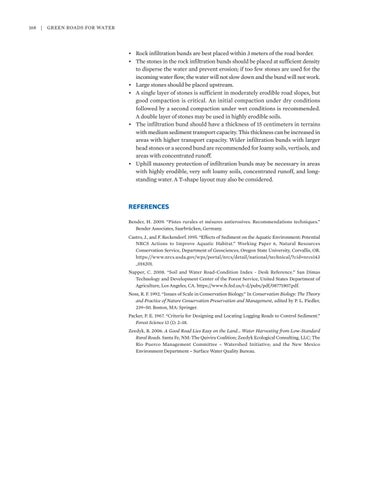168 | Green Roads for Water
• Rock infiltration bunds are best placed within 3 meters of the road border. • The stones in the rock infiltration bunds should be placed at sufficient density to disperse the water and prevent erosion; if too few stones are used for the incoming water flow, the water will not slow down and the bund will not work. • Large stones should be placed upstream. • A single layer of stones is sufficient in moderately erodible road slopes, but good compaction is critical. An initial compaction under dry conditions followed by a second compaction under wet conditions is recommended. A double layer of stones may be used in highly erodible soils. • The infiltration bund should have a thickness of 15 centimeters in terrains with medium sediment transport capacity. This thickness can be increased in areas with higher transport capacity. Wider infiltration bunds with larger head stones or a second bund are recommended for loamy soils, vertisols, and areas with concentrated runoff. • Uphill masonry protection of infiltration bunds may be necessary in areas with highly erodible, very soft loamy soils, concentrated runoff, and longstanding water. A T-shape layout may also be considered.
REFERENCES Bender, H. 2009. “Pistes rurales et mésures antierosives. Recommendations techniques.” Bender Associates, Saarbrücken, Germany. Castro, J., and F. Reckendorf. 1995. “Effects of Sediment on the Aquatic Environment: Potential NRCS Actions to Improve Aquatic Habitat.” Working Paper 6, Natural Resources Conservation Service, Department of Geosciences, Oregon State University, Corvallis, OR. https://www.nrcs.usda.gov/wps/portal/nrcs/detail/national/technical/?cid=nrcs143 _014201. Napper, C. 2008. “Soil and Water Road-Condition Index - Desk Reference.” San Dimas Technology and Development Center of the Forest Service, United States Department of Agriculture, Los Angeles, CA. https://www.fs.fed.us/t-d/pubs/pdf/08771807.pdf. Noss, R. F. 1992. “Issues of Scale in Conservation Biology.” In Conservation Biology: The Theory and Practice of Nature Conservation Preservation and Management, edited by P. L. Fiedler, 239–50. Boston, MA: Springer. Packer, P. E. 1967. “Criteria for Designing and Locating Logging Roads to Control Sediment.” Forest Science 13 (1): 2–18. Zeedyk, B. 2006. A Good Road Lies Easy on the Land... Water Harvesting from Low-Standard Rural Roads. Santa Fe, NM: The Quivira Coalition; Zeedyk Ecological Consulting, LLC; The Rio Puerco Management Committee – Watershed Initiative; and the New Mexico Environment Department – Surface Water Quality Bureau.







































